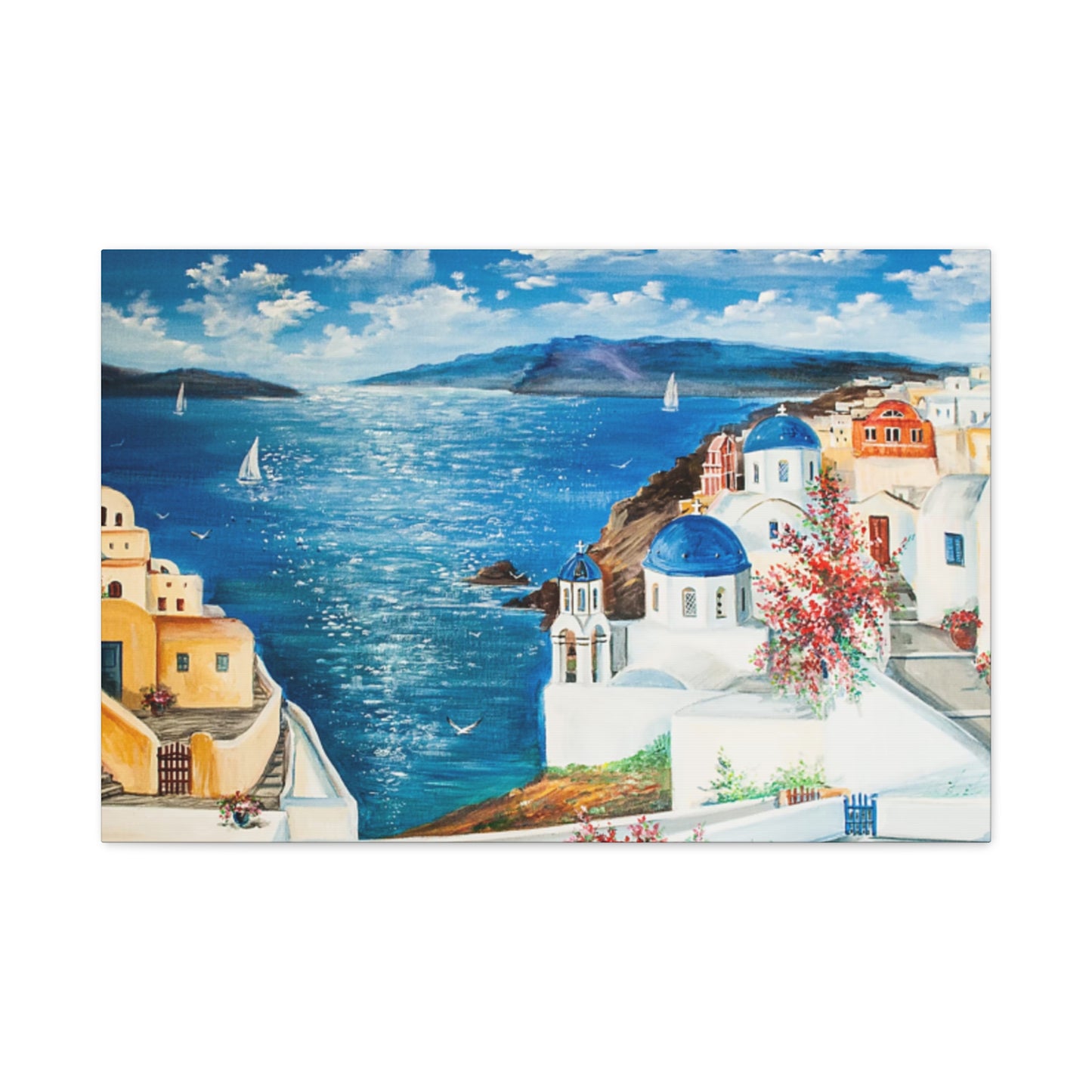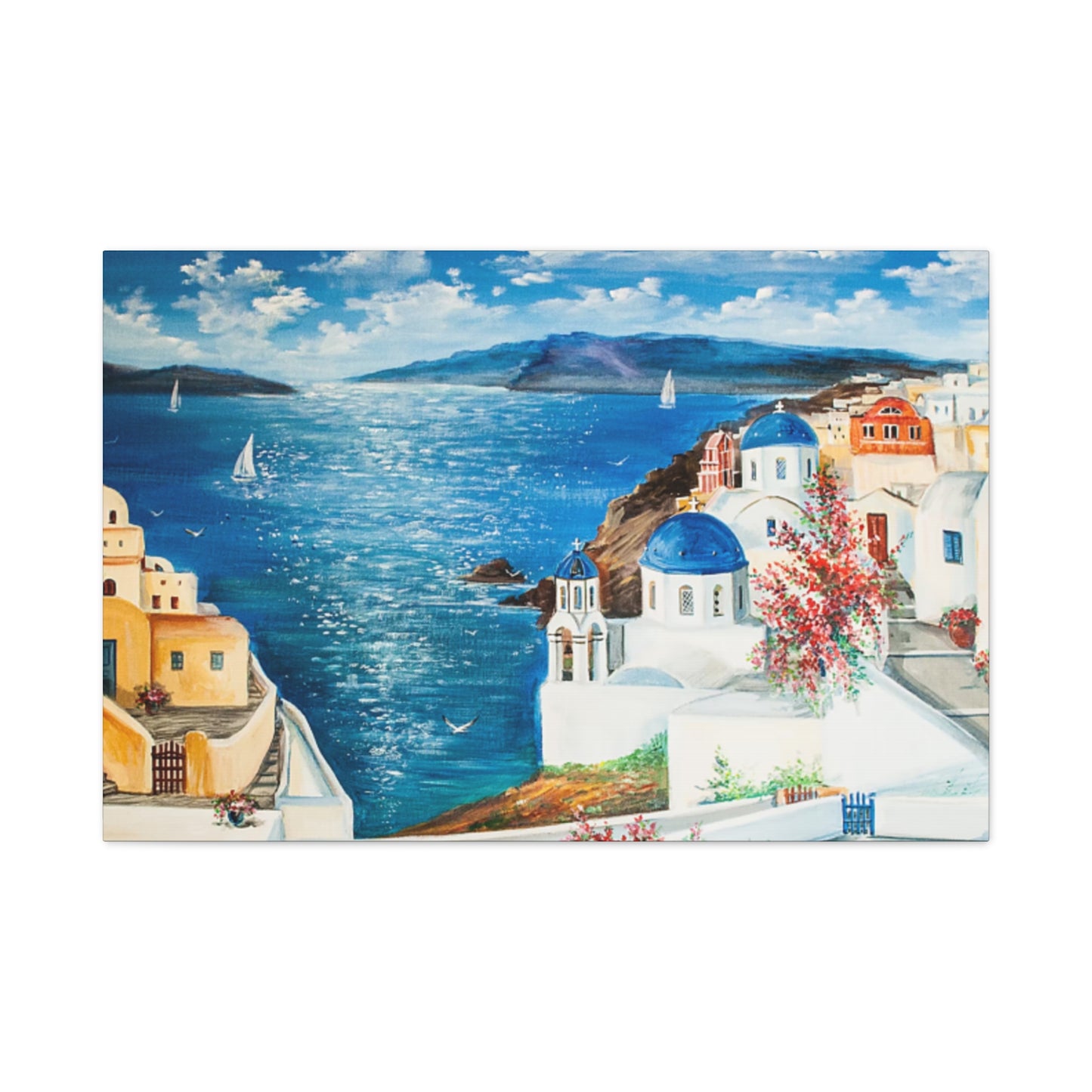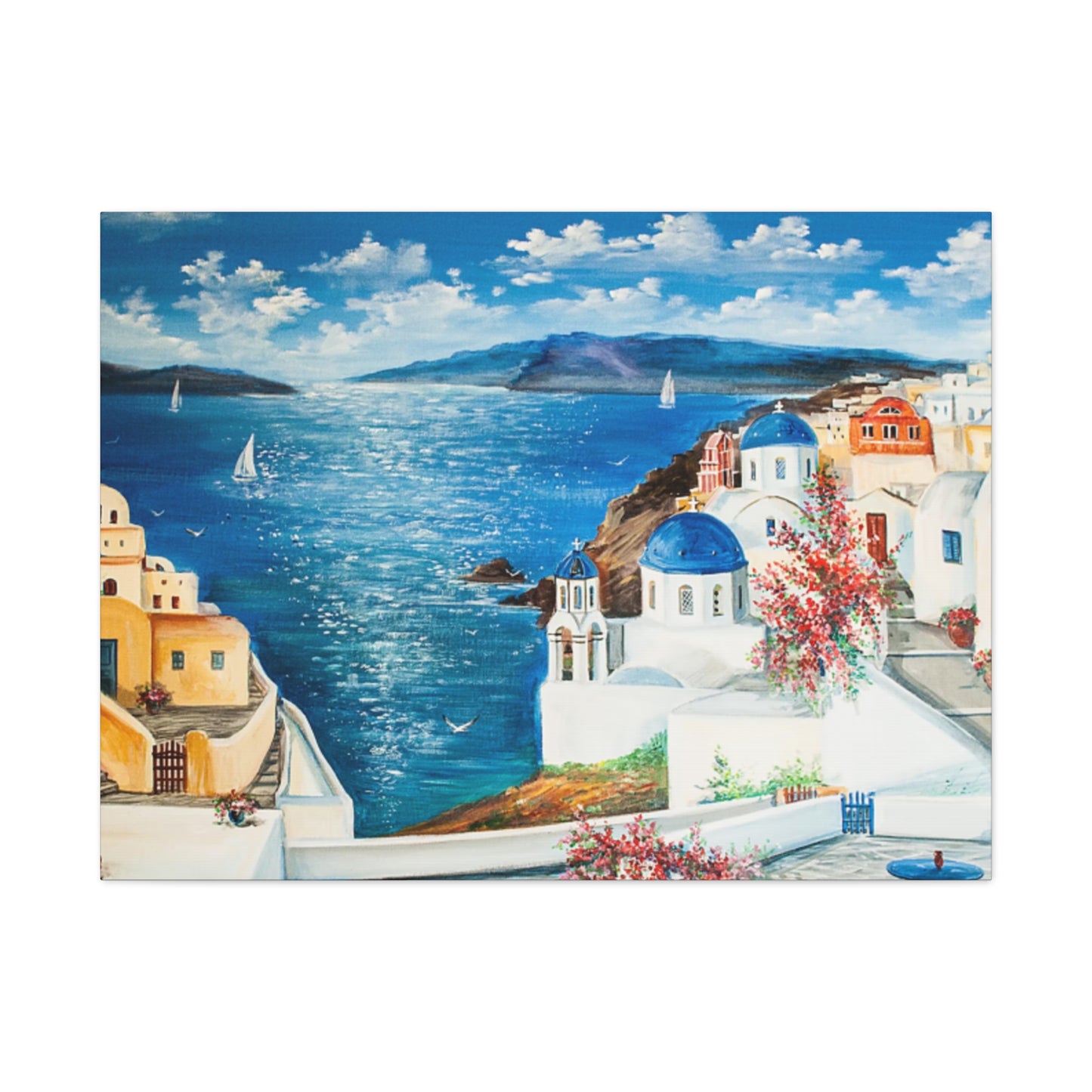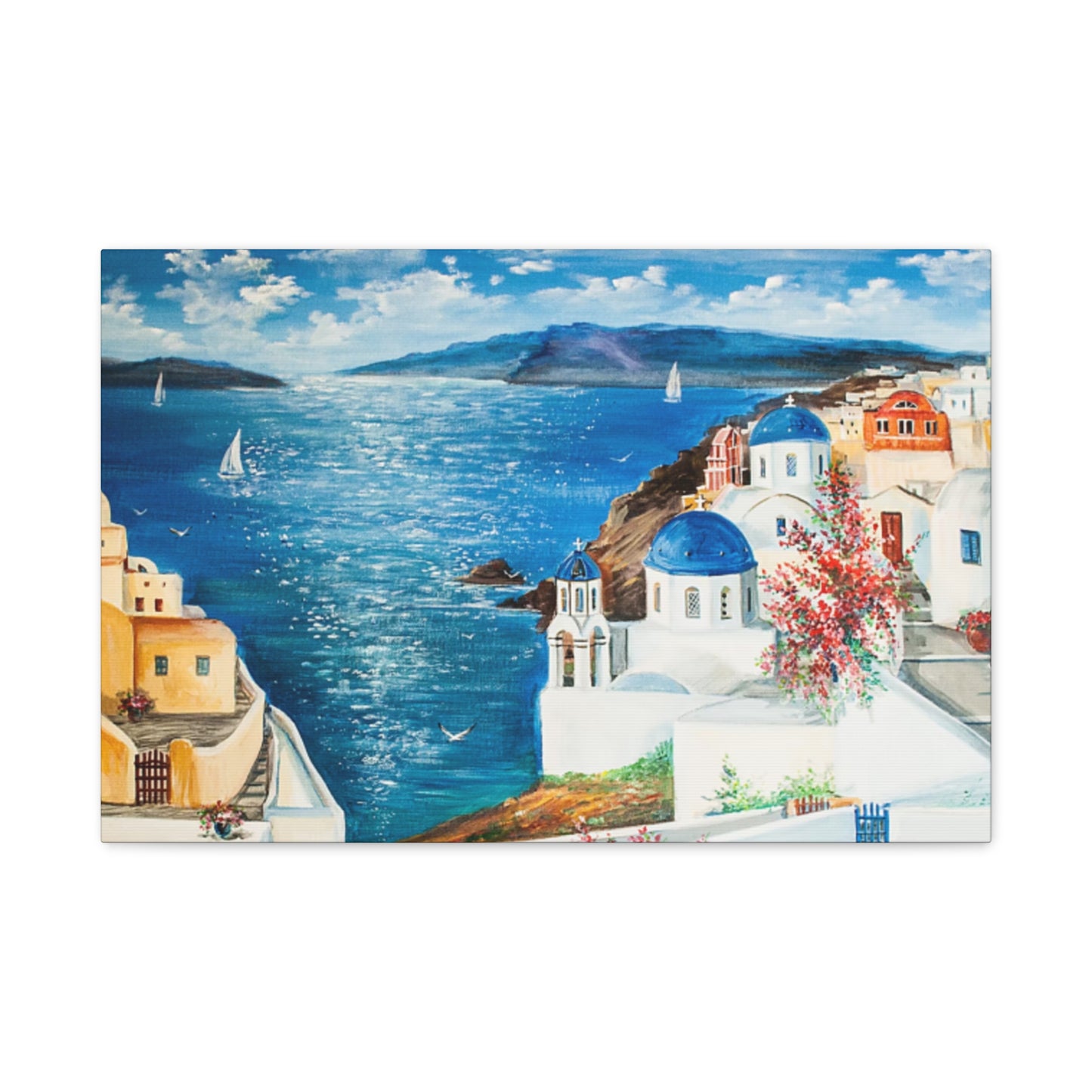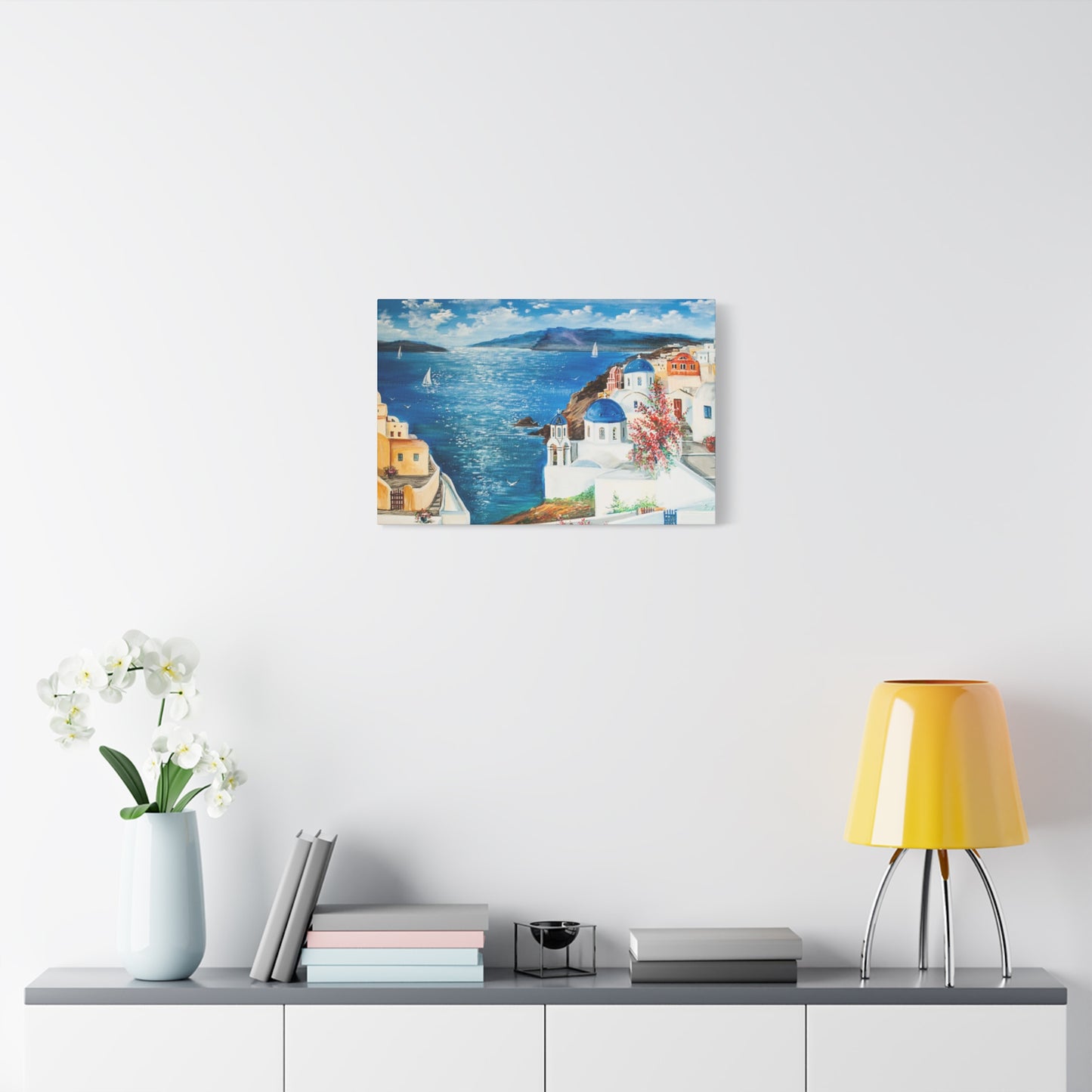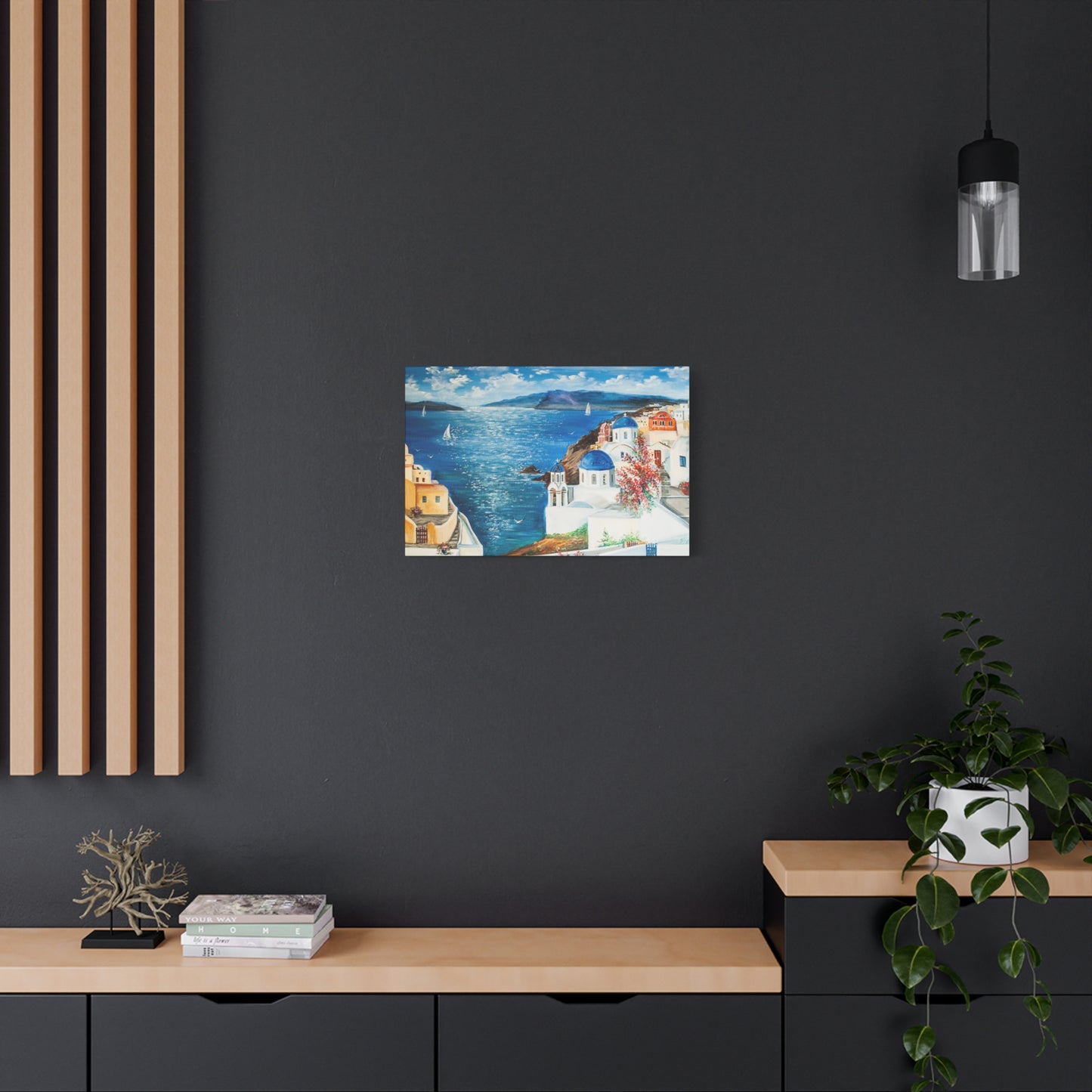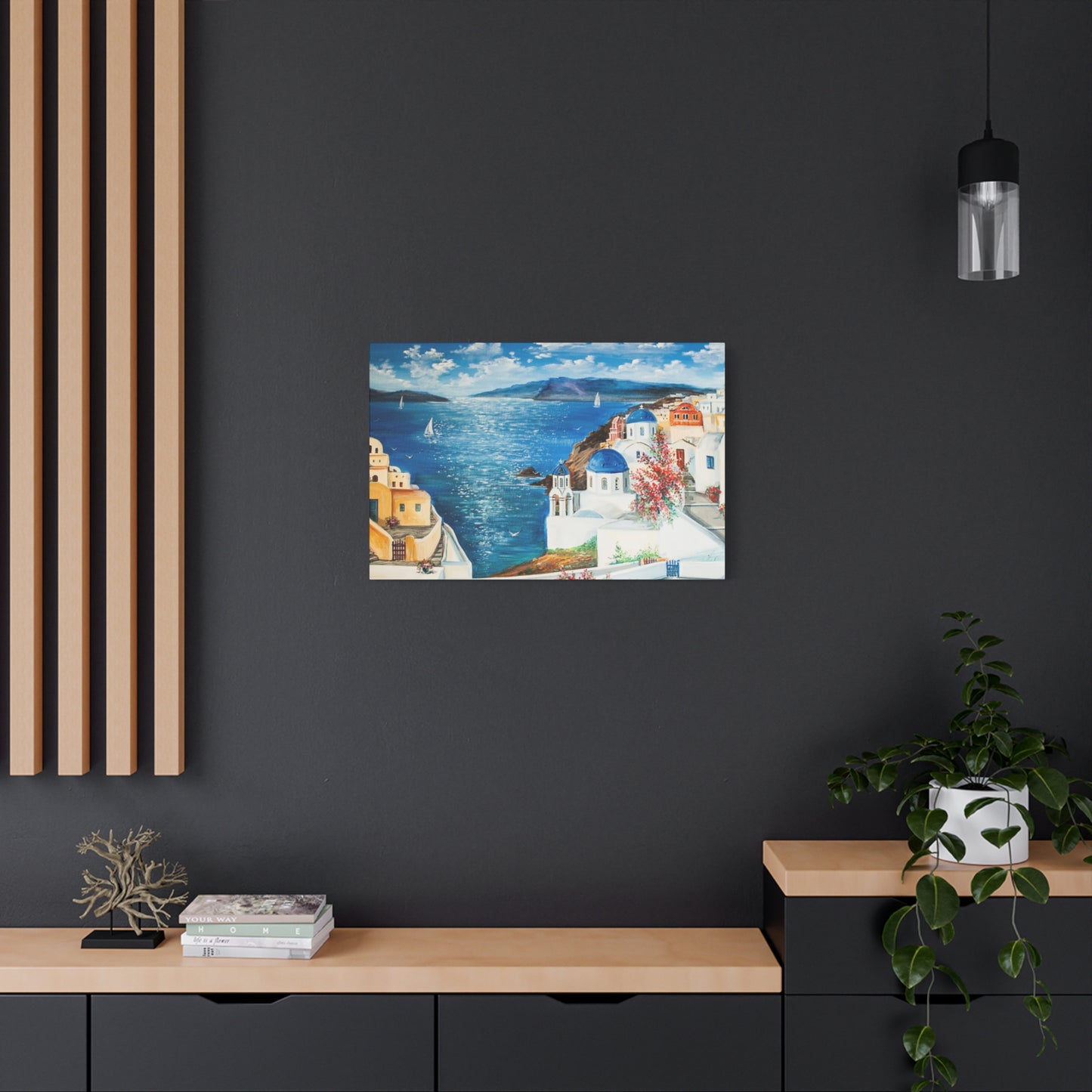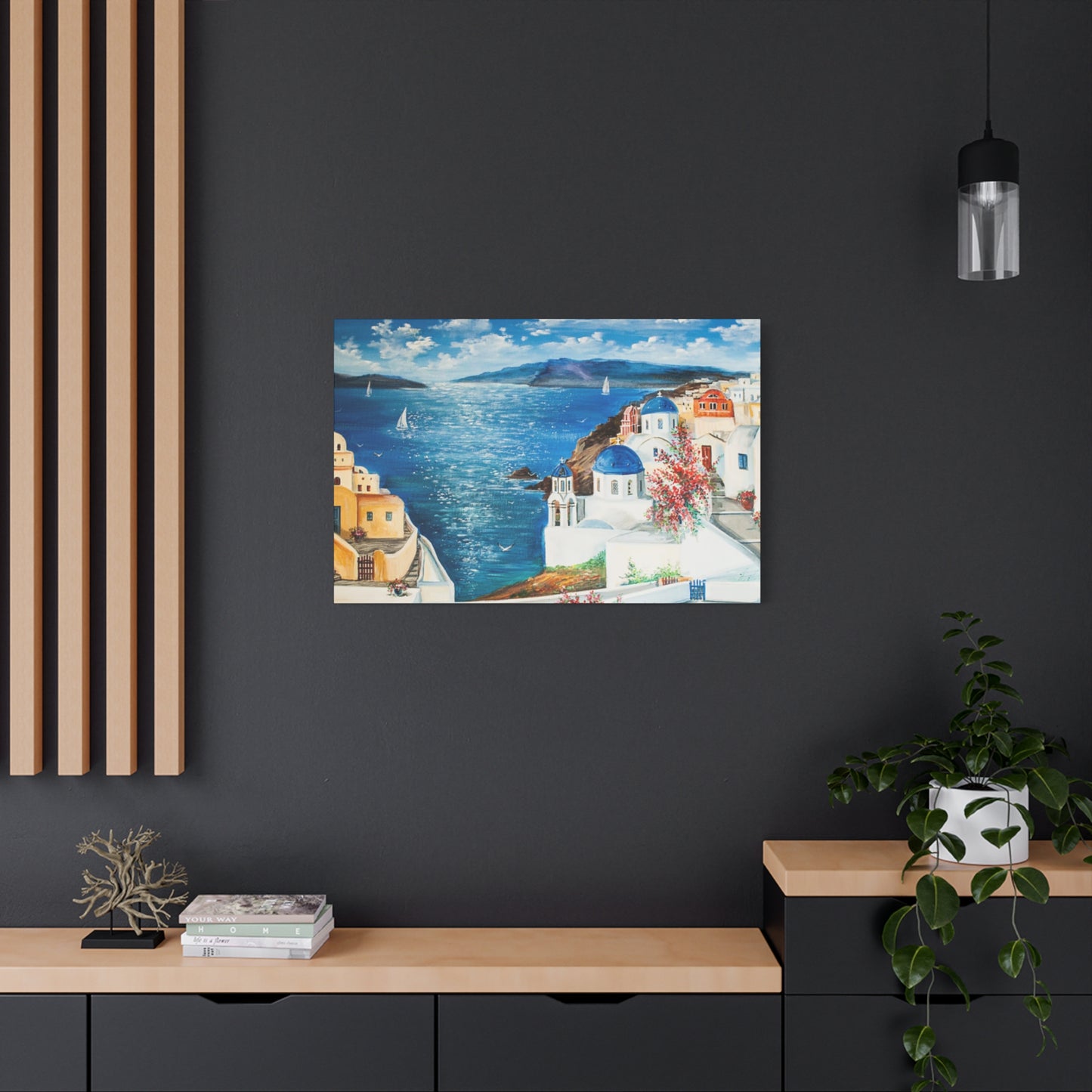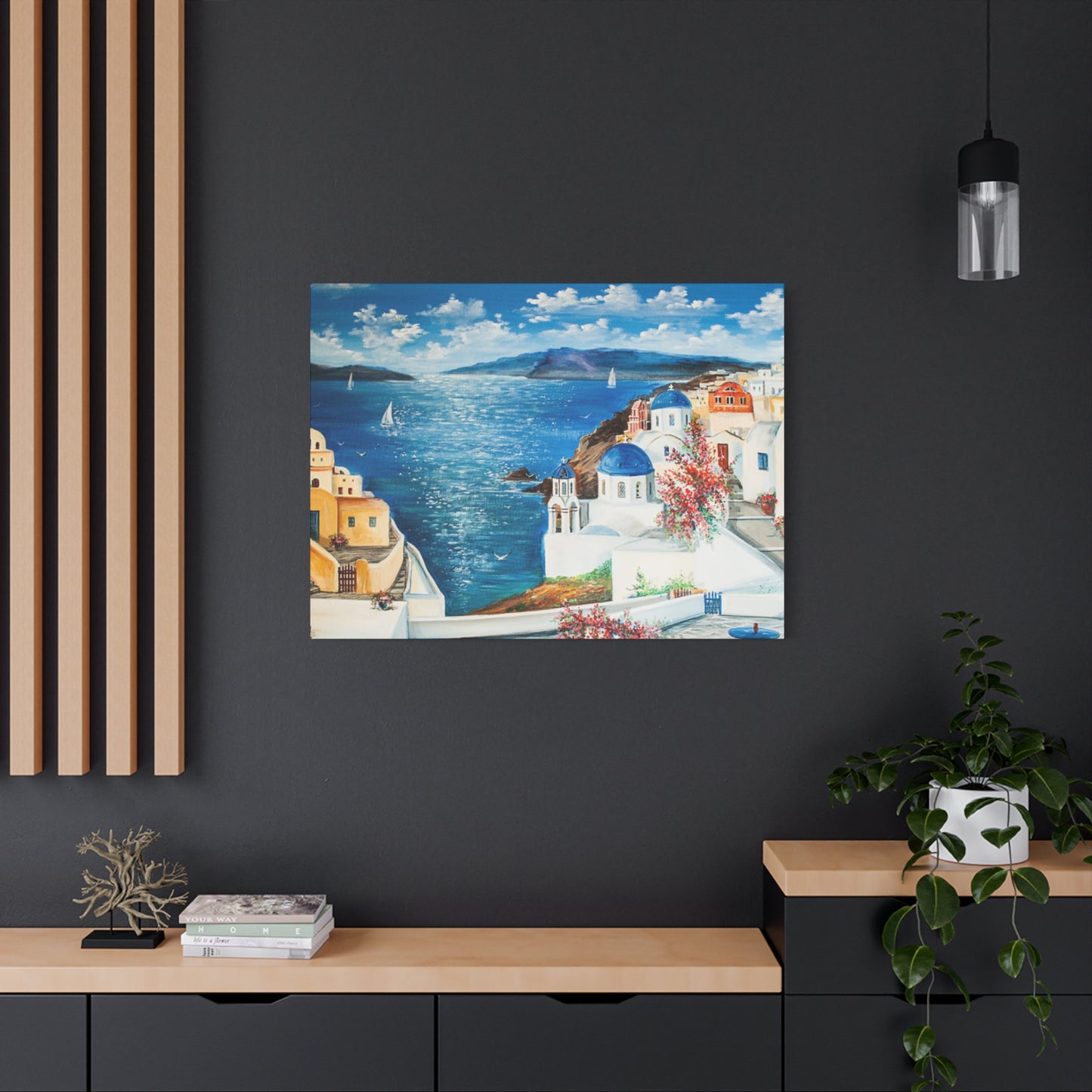Decorating with Greece Sea Painting Wall Art: Tips and Ideas
The allure of Greece waters has captivated artists and art enthusiasts for centuries, creating a timeless appeal that transcends cultural boundaries. Greece sea wall art represents more than mere decoration; it embodies the essence of Mediterranean culture, the tranquility of azure waters, and the romantic spirit of ancient civilizations. These artistic masterpieces transport viewers to sun-drenched islands, crystalline waters, and picturesque harbors that have inspired countless generations of artists, writers, and dreamers.
The Mediterranean aesthetic has become increasingly popular in contemporary home decoration, with Greece sea paintings leading the charge in bringing coastal elegance to residential environments. These artworks capture the unique quality of light that dances across Aegean waters, the distinctive architecture of whitewashed buildings cascading down hillsides, and the timeless beauty of traditional fishing vessels bobbing gently in secluded coves. The popularity of Greece sea wall art stems from its ability to evoke powerful emotional responses, creating environments that promote relaxation, contemplation, and a sense of escape from daily stresses.
Modern homeowners increasingly seek authentic artistic expressions that reflect their personal tastes while creating welcoming atmospheres. Greece sea wall art fulfills this desire by offering sophisticated visual narratives that celebrate natural beauty while honoring artistic tradition. These pieces serve as conversation starters, mood enhancers, and focal points that anchor entire decorative schemes. Whether rendered in traditional oil painting techniques or contemporary digital formats, Greece sea artworks maintain their power to transform ordinary rooms into extraordinary havens.
The versatility of Greece sea wall art makes it suitable for various architectural styles and decorative preferences. From minimalist contemporary homes to traditional Mediterranean villas, these artworks adapt seamlessly to different environments while maintaining their distinctive character. The color palettes typically associated with Greece seascapes - brilliant blues, pristine whites, warm terracottas, and golden sunset hues - complement a wide range of existing color schemes while adding sophisticated visual interest.
The Magnificence of Greece Maritime Landscapes on Canvas
Greece maritime landscapes represent some of the most breathtaking natural scenery found anywhere in the world, characterized by their extraordinary clarity, vibrant color contrasts, and dramatic geological formations. These landscapes have provided endless inspiration for artists who seek to capture the unique interplay between sea and sky that defines the Greece maritime experience. The distinctive topography of the Greece islands, with their steep cliffs plunging into deep blue waters, creates natural amphitheaters where light and shadow perform daily spectacles of unparalleled beauty.
The geological diversity of Greece coastal regions offers artists an incredible variety of subjects, from the volcanic drama of Santorini with its distinctive black and red beaches to the gentle, sandy shores of Crete and the mysterious sea caves of Zakynthos. Each location presents unique challenges and opportunities for artistic interpretation, resulting in a rich tapestry of visual narratives that celebrate the diverse character of Greece maritime landscapes. Artists working in this tradition must master the subtle nuances of Mediterranean light, which differs significantly from northern European or American coastal illumination.
Professional artists who specialize in Greece maritime scenes often spend considerable time studying the specific qualities of light and atmosphere that characterize different regions and seasons. The summer light of the Cyclades possesses a crystalline clarity that renders distant islands with remarkable definition, while autumn brings warmer, more golden tones that emphasize the rustic character of traditional fishing villages. Spring light often carries a silvery quality that enhances the dramatic contrasts between dark rocky outcroppings and brilliant white architectural elements.
The technical challenges of capturing Greece seascapes on canvas require sophisticated understanding of color theory, atmospheric perspective, and the complex interactions between natural and man-made elements. Successful Greece sea paintings must balance the intense blues and whites that dominate the palette while incorporating the subtle earth tones of ancient stone, weathered wood, and Mediterranean vegetation. Artists must also master the representation of water in its various states - from the mirror-like calm of protected harbors to the dynamic energy of waves breaking against rocky shores.
The emotional resonance of Greece maritime landscapes extends beyond their obvious visual appeal to encompass cultural and historical associations that enrich the viewing experience. These scenes evoke ancient maritime traditions, legendary voyages, and the timeless relationship between Greece civilization and the sea. Contemporary viewers often experience a profound sense of connection to these landscapes, even if they have never visited Greece, suggesting that these images tap into universal human responses to natural beauty and maritime environments.
Canvas reproduction techniques have evolved significantly in recent decades, allowing high-quality prints of Greece maritime paintings to achieve remarkable fidelity to original artworks. Modern printing technologies can capture subtle gradations in color and texture that were previously impossible to reproduce, making museum-quality Greece sea art accessible to a broader audience. These advances have democratized access to exceptional maritime art while maintaining the visual impact and emotional resonance of original paintings.
Incorporating Greece Maritime Artwork into Coastal Home Themes
The integration of Greece maritime artwork into coastal decorating schemes requires thoughtful consideration of color relationships, scale proportions, and thematic coherence. Successful coastal decorating goes beyond simply hanging seascapes on walls; it involves creating comprehensive environmental experiences that transport inhabitants and guests to seaside locations through carefully orchestrated visual, textural, and atmospheric elements. Greece sea paintings serve as anchor points for these decorative narratives, providing focal points around which other design elements can be organized and unified.
Color coordination represents one of the most critical aspects of incorporating Greece sea art into coastal themes. The distinctive palette of Greece seascapes - dominated by various shades of blue, white, and earth tones - must be echoed and complemented throughout the surrounding decorative elements. This might involve selecting furniture pieces in weathered wood tones that echo the driftwood grays found in many Greece harbor scenes, or choosing textile elements in shades of blue that harmonize with the water tones in the selected artwork.
Textural considerations play equally important roles in creating successful coastal environments enhanced by Greece sea art. The smooth, polished surfaces suggested by calm water scenes call for complementary materials such as polished marble, glass, or ceramic elements, while more dynamic seascapes featuring crashing waves might be better complemented by rougher textures such as natural fiber rugs, woven baskets, or rustic wooden furniture. The goal is to create textural conversations between the artwork and its physical environment that enhance rather than compete with the visual narrative.
Scale relationships require careful planning to ensure that Greece sea paintings achieve their intended impact without overwhelming their surroundings. Large-scale seascapes work best in rooms with generous proportions and minimal competing visual elements, where they can serve as dominant focal points. Smaller works often benefit from grouping arrangements that create collective visual impact while allowing individual pieces to maintain their distinct characteristics. The viewing distance must also be considered, as detailed paintings require closer examination while impressionistic works may be more effective when viewed from greater distances.
Lighting design plays a crucial role in maximizing the impact of Greece sea artwork within coastal decorating schemes. Natural light, when available, should be carefully managed to avoid direct sunlight that might damage artwork while providing sufficient illumination to reveal color subtleties and textural details. Artificial lighting systems should be designed to complement rather than compete with the natural light qualities depicted in the paintings themselves. Warm lighting tends to enhance sunset scenes, while cooler lighting better suits midday maritime subjects.
The psychological effects of Greece sea artwork in coastal environments extend beyond mere visual pleasure to encompass therapeutic benefits associated with maritime imagery. Studies have shown that seascapes can reduce stress, lower blood pressure, and promote feelings of calm and well-being. When incorporated into living environments, Greece sea paintings can create daily opportunities for mental escape and relaxation, transforming ordinary rooms into restorative retreats that support emotional and psychological health.
Storage and maintenance considerations must be addressed when incorporating original or high-quality reproduction Greece sea artwork into coastal homes. Humidity control becomes particularly important in actual coastal locations, where salt air and moisture fluctuations can damage artwork over time. Proper framing, appropriate hanging hardware, and regular maintenance schedules help ensure that these valuable decorative investments continue to provide enjoyment for years to come.
Trending Approaches in Greece Maritime Wall Artwork
Contemporary approaches to Greece maritime wall artwork reflect evolving aesthetic preferences while honoring traditional artistic techniques and subject matter. Modern artists working in this genre often blend classical representational methods with contemporary stylistic innovations, creating works that speak to current audiences while maintaining connection to historical maritime painting traditions. These evolving approaches encompass various stylistic movements, technical innovations, and conceptual frameworks that expand the possibilities for Greece sea art expression.
Photorealistic approaches have gained significant popularity among both artists and collectors who appreciate the technical virtuosity required to achieve near-photographic accuracy in painted seascapes. These works often focus on capturing specific moments in time with extraordinary precision, documenting particular lighting conditions, weather patterns, or seasonal variations with scientific accuracy. Photorealistic Greece sea paintings appeal to viewers who desire artwork that functions as windows into actual Mediterranean locations, providing vicarious travel experiences through visual immersion.
Impressionistic interpretations continue to enjoy widespread appeal, particularly among collectors who appreciate the emotional resonance and artistic interpretation that characterize this approach. Contemporary impressionist artists working with Greece maritime subjects often employ bold brushwork, vibrant color choices, and simplified compositional structures to capture the essence rather than the literal appearance of seascapes. These works emphasize mood, atmosphere, and emotional response over documentary accuracy, creating artworks that function as emotional rather than visual records of maritime experiences.
Abstract expressionist approaches to Greece sea subjects push the boundaries of traditional maritime painting by focusing on color relationships, gestural mark-making, and emotional expression rather than recognizable subject matter. These works might capture the energy of wind and waves through dynamic brushstrokes, or explore the psychological effects of sea and sky through experimental color combinations. Abstract Greece sea art appeals to viewers who prefer conceptual rather than literal interpretations of maritime themes.
Mixed media approaches combine traditional painting techniques with contemporary materials and methods, creating artworks that bridge historical and modern artistic practices. These might incorporate actual sand, shells, or other maritime materials into painted surfaces, or combine painting with photography, digital manipulation, or sculptural elements. Mixed media Greece sea art often appeals to collectors who appreciate innovative artistic approaches while maintaining connection to traditional maritime subjects.
Digital art techniques have opened new possibilities for creating and reproducing Greece sea artwork, allowing artists to achieve effects and color combinations that would be difficult or impossible using traditional materials. Digital artists can manipulate lighting, color saturation, and atmospheric effects with unprecedented precision, creating hyper-realistic or fantastical interpretations of Greece seascapes. Digital reproduction also allows for easy customization of size, color, and compositional elements to suit specific decorative requirements.
Contemporary framing and presentation approaches have evolved to complement modern aesthetic preferences while protecting and enhancing Greece sea artwork. Minimalist framing styles that emphasize clean lines and neutral colors allow artwork to take center stage, while more elaborate frames can add decorative elements that complement traditional or eclectic decorating schemes. Alternative presentation methods, such as canvas wraps, metal prints, or acrylic mounting, offer contemporary alternatives to traditional framing while providing protection and visual enhancement.
The influence of social media and online galleries has significantly impacted trending approaches to Greece maritime art, as artists and galleries adapt their work to achieve maximum impact in digital presentation formats. This has led to increased emphasis on bold colors, striking compositions, and dramatic lighting effects that reproduce effectively in online formats. Artists increasingly consider how their work will appear in social media posts and online galleries, influencing creative decisions and artistic approaches.
Azure Hues and Illumination in Greece Maritime Paintings
The distinctive blue tones found in Greece maritime paintings represent one of the most recognizable and beloved aspects of this artistic genre. These blues range from the deep, mysterious tones of open ocean waters to the brilliant turquoise of shallow lagoons, each requiring specific technical approaches and color mixing techniques to achieve authentic representation. Understanding the nuances of blue coloration in Greece seascapes involves appreciating both the scientific properties of light and water interaction and the artistic traditions that have evolved to capture these phenomena on canvas.
The physics of light interaction with Mediterranean waters creates unique optical conditions that distinguish Greece seascapes from maritime scenes in other geographic regions. The clarity of Mediterranean water allows light to penetrate to significant depths before being reflected back to the surface, creating the characteristic transparency and luminosity that defines Greece sea blues. Additionally, the high mineral content and specific plankton populations in Mediterranean waters contribute to distinctive color characteristics that experienced maritime artists learn to recognize and reproduce.
Professional artists specializing in Greece seascapes often develop personalized color palettes based on extensive observation and experimentation with various blue pigments and mixing techniques. Traditional ultramarine blue, derived from ground lapis lazuli, was historically prized for its intensity and permanence in maritime paintings. Contemporary artists have access to a wider range of synthetic blue pigments, including phthalo blue, cerulean blue, and manganese blue, each offering distinct characteristics in terms of transparency, mixing properties, and color temperature.
The representation of light in Greece maritime paintings requires sophisticated understanding of how illumination affects color perception and atmospheric perspective. Mediterranean light possesses unique qualities that differ significantly from northern European or North American lighting conditions. The intense clarity and warmth of Greece sunlight creates strong contrasts between illuminated and shadowed areas while maintaining remarkable color saturation even in shadowed regions. Artists must master these lighting characteristics to create convincing Greece seascapes that capture the authentic feel of Mediterranean environments.
Seasonal variations in light quality significantly impact the appearance of Greece waters and must be considered when creating maritime artwork intended to represent specific times of year. Summer light tends to be more intense and direct, creating sharper contrasts and more saturated colors, while winter light often carries a silvery quality that softens transitions and creates more subtle color gradations. Spring and autumn lighting conditions each possess distinct characteristics that experienced artists learn to recognize and incorporate into their work.
The technical challenges of mixing and applying blue pigments to achieve authentic Greece sea colors require considerable skill and experience. Artists must understand how different pigments behave when mixed with white to create lighter tones, how they interact with other colors to create realistic shadow areas, and how they respond to various painting mediums and application techniques. The goal is to create blue tones that appear natural and convincing while maintaining their intensity and luminosity over time.
Time-of-day considerations significantly impact the color and lighting characteristics of Greece seascapes, requiring artists to carefully observe and document how maritime scenes change throughout daily light cycles. Early morning light often creates cooler blue tones with silvery highlights, while midday illumination produces the most saturated and contrasted colors. Late afternoon and sunset lighting introduces warm tones that must be carefully balanced with blue water colors to maintain realistic color relationships.
The psychological effects of blue coloration in Greece maritime art contribute significantly to the emotional impact and therapeutic value of these works. Blue tones are widely recognized for their calming and stress-reducing properties, making Greece seascapes particularly effective for creating relaxing environments. The specific blues found in authentic Greece sea paintings often evoke feelings of peace, freedom, and escape that enhance the decorative and psychological value of these artworks.
Abstract versus Photorealistic Greece Maritime Paintings
The artistic spectrum between abstract and photorealistic approaches to Greece maritime painting offers collectors and decorators diverse options for incorporating Mediterranean sea themes into their environments. Each approach serves different aesthetic preferences, functional requirements, and emotional needs, making the choice between abstract and realistic styles an important consideration in selecting appropriate artwork for specific settings and purposes.
Photorealistic Greece maritime paintings prioritize accurate representation of observable details, lighting conditions, and natural phenomena. These works often require extensive technical skill and considerable time investment to achieve their documentary-like quality. Photorealistic artists typically work from high-quality photographic references or extended plein air observation sessions, carefully studying the subtle variations in color, texture, and light that characterize actual Greece seascapes. The resulting artworks function as visual records of specific locations and moments, offering viewers detailed glimpses into Mediterranean maritime environments.
The appeal of photorealistic Greece sea paintings lies in their ability to transport viewers to specific locations through visual accuracy and detail. These works often serve as substitutes for actual travel, allowing viewers to experience the visual richness of Greece seascapes without leaving their homes. Photorealistic paintings also appeal to collectors who appreciate technical virtuosity and craftsmanship, as the skill required to achieve convincing photorealistic effects commands respect and admiration from viewers familiar with artistic techniques.
Abstract approaches to Greece maritime subjects prioritize emotional expression, color relationships, and compositional dynamics over literal representation. Abstract artists working with sea themes might focus on capturing the energy and movement of waves through gestural brushwork, explore color harmonies inspired by Mediterranean palettes, or create compositional structures that suggest rather than explicitly depict maritime elements. Abstract Greece sea art appeals to viewers who prefer interpretive rather than documentary approaches to artistic expression.
The advantages of abstract Greece maritime art include greater flexibility in color choices, compositional arrangements, and size adaptations. Abstract works can be easily customized to complement specific decorative schemes or architectural requirements without being constrained by realistic color relationships or proportional accuracy. Abstract seascapes also tend to maintain their visual interest over extended viewing periods, as viewers can discover new details and relationships within the work that might not be immediately apparent.
Contemporary artists often work in hybrid approaches that combine realistic and abstract elements within single compositions. These works might feature photorealistic water effects combined with simplified or stylized architectural elements, or realistic boats and figures set within abstract atmospheric environments. Hybrid approaches offer the visual interest and technical accomplishment of realistic rendering while maintaining the flexibility and interpretive freedom of abstract expression.
The choice between abstract and photorealistic Greece maritime art often depends on the intended function and context of the artwork. Photorealistic pieces work well in settings where educational or documentary value is important, such as travel agencies, cultural centers, or homes where Greece heritage is celebrated. Abstract works often function better in contemporary architectural settings where literal representation might compete with existing design elements or where the artwork needs to complement rather than dominate its environment.
Scale considerations play important roles in determining the effectiveness of abstract versus photorealistic approaches. Large-scale photorealistic works require substantial wall areas and appropriate viewing distances to achieve their intended impact, while abstract compositions can often work effectively at various scales and viewing distances. Small photorealistic works might lose their impact due to detail compression, while small abstract works can maintain their visual strength through bold color relationships and dynamic compositions.
The longevity and timelessness of abstract versus photorealistic approaches also merit consideration. Photorealistic works might eventually appear dated as artistic styles and techniques evolve, while well-executed abstract pieces often possess timeless qualities that transcend specific artistic movements or periods. However, this varies significantly depending on the skill and vision of individual artists rather than being an inherent characteristic of either approach.
Large-Format Greece Maritime Canvas Prints for Maximum Visual Impact
Large-format Greece maritime canvas prints have become increasingly popular as homeowners and commercial decorators recognize their power to transform environments through dramatic visual impact. These substantial artworks serve as commanding focal points that can anchor entire decorative schemes while creating immersive experiences that transport viewers to Mediterranean coastlines. The success of large-format Greece sea prints depends on careful consideration of scale relationships, viewing distances, installation requirements, and environmental factors.
The psychological impact of large-scale maritime artwork extends far beyond simple visual pleasure to encompass therapeutic and emotional benefits associated with expansive natural imagery. Large Greece seascapes can create illusions of expanded boundaries, making rooms appear larger and more open while providing visual escape routes that reduce feelings of confinement or stress. The immersive quality of properly sized maritime prints can transform ordinary rooms into extraordinary environments that support relaxation, contemplation, and emotional well-being.
Technical considerations for large-format Greece maritime prints require careful attention to image resolution, printing methods, and material quality. High-resolution source images are essential to maintain detail clarity and color accuracy when enlarged to significant dimensions. Professional printing facilities use specialized equipment and techniques to ensure consistent color reproduction and proper ink saturation across large surface areas. The choice of canvas material, stretcher construction, and protective coatings significantly impacts both the appearance and longevity of large-format prints.
Installation requirements for large-format Greece maritime canvas prints often involve structural considerations beyond simple picture hanging. Heavy pieces require substantial wall anchoring systems and may need professional installation to ensure safety and proper positioning. Ceiling height, room proportions, and furniture arrangements must be carefully evaluated to determine appropriate sizes and placement locations. Large prints often work best when positioned to take advantage of natural lighting while avoiding direct sunlight exposure that could cause fading or other damage.
The viewing experience of large-format Greece maritime prints changes significantly based on observer distance and angle. These works are typically designed to be effective from multiple viewing distances, offering broad compositional impact when viewed from across a room and detailed interest when examined from closer range. The curved perspective created by very large prints can create immersive effects that enhance the feeling of being present within the depicted scene.
Room proportion relationships critically influence the success of large-format Greece maritime artwork. Rooms with generous ceiling heights and adequate wall boundaries can accommodate substantial prints without overwhelming the environment, while smaller rooms might benefit from medium-sized pieces that provide impact without dominating their surroundings. Professional decorators often recommend that large artwork should occupy roughly one-quarter to one-third of available wall boundary to achieve proper visual balance.
Lighting design becomes particularly critical when displaying large-format Greece maritime prints, as inadequate illumination can reduce their impact while excessive or improperly directed lighting can create glare or uneven illumination patterns. Track lighting systems, picture lights, or strategically placed accent lighting can enhance the visual impact of large prints while protecting them from potentially damaging direct illumination. Natural lighting should be carefully managed through window treatments or UV-filtering glass.
The economic considerations of large-format Greece maritime canvas prints often make them attractive alternatives to original paintings of comparable size. High-quality reproduction technology allows collectors to obtain museum-quality prints at fractions of the cost of original artworks while still achieving significant decorative impact. Limited edition prints often provide additional collectible value while maintaining accessibility compared to unique original paintings.
The Significance of Vessels and Fishing Imagery in Maritime Art
Traditional Greece fishing boats and sailing vessels represent essential elements in authentic maritime art, serving as both compositional anchors and cultural symbols that connect contemporary viewers to ancient Mediterranean traditions. These vessels carry profound symbolic meanings beyond their obvious decorative function, representing human relationships with the sea, traditional ways of life, and the enduring connection between Greece culture and maritime environments. Understanding the significance of boats in Greece sea art enhances appreciation for these works while providing insights into their cultural and historical contexts.
The distinctive design characteristics of traditional Greece fishing boats reflect centuries of adaptation to specific Mediterranean conditions and fishing practices. These vessels, known as caiques, feature distinctive hull shapes, rigging configurations, and decorative elements that make them immediately recognizable to viewers familiar with Greece maritime culture. Artists who accurately depict these boats must understand their structural details, proportional relationships, and typical positioning within harbor and coastal settings.
Historical context surrounding Greece fishing traditions adds layers of meaning to maritime artwork that includes vessel imagery. These boats represent continuity with ancient maritime practices that have sustained Greece coastal communities for thousands of years. Contemporary viewers often respond emotionally to these symbols of traditional life, even if they have no personal connection to maritime activities, suggesting that boat imagery taps into universal human responses to craftsmanship, tradition, and relationship with natural environments.
The compositional function of boats in Greece maritime paintings extends beyond simple subject matter to encompass important structural roles within artistic compositions. Boats can serve as foreground elements that establish scale relationships, middle-ground features that provide visual interest and narrative content, or background elements that suggest distance and atmospheric perspective. Skilled artists use boat placement and sizing to guide viewer attention and create visual pathways through their compositions.
Color relationships between boats and surrounding water and sky elements require careful consideration to achieve realistic and aesthetically pleasing results. Traditional Greece fishing boats often feature distinctive color schemes - bright blues, whites, and earth tones - that must be balanced with water colors and atmospheric elements to maintain visual harmony. Weathered and aged vessel surfaces provide opportunities for artists to explore complex color relationships and textural contrasts that add visual interest and authenticity.
The seasonal and time-of-day implications of including boats in maritime scenes add temporal dimensions that enhance narrative content and viewer engagement. Morning harbor scenes with boats preparing for departure suggest activity and anticipation, while evening scenes with returning vessels imply completion and rest. Seasonal variations in boat positioning, rigging, and maintenance activities provide artists with rich source material for creating works that capture specific moments in maritime life cycles.
Different types of vessels serve various compositional and symbolic functions within Greece maritime art. Small fishing boats suggest intimate, personal relationships with the sea, while larger sailing vessels might represent adventure, commerce, or historical connections to ancient maritime traditions. Luxury yachts and modern recreational boats can add contemporary elements to traditional seascapes, creating interesting temporal contrasts within single compositions.
The technical challenges of accurately rendering boats within maritime settings require understanding of marine architecture, perspective relationships, and the effects of water reflection and movement on vessel appearance. Boats sitting in water present complex drawing and painting challenges, as artists must correctly represent how vessels float, how water interacts with hull shapes, and how reflections appear on water surfaces with varying degrees of movement and clarity.
The emotional resonance of fishing and sailing imagery often evokes romantic notions of maritime life that may differ significantly from the realities of commercial fishing or recreational boating. Artists working in this tradition must balance romantic idealization with authentic representation, creating works that capture the appeal of maritime life while maintaining credibility with viewers familiar with actual boating experiences.
Professional Framing Techniques for Greece Maritime Artwork
Proper framing represents one of the most critical factors in maximizing the visual impact and longevity of Greece maritime artwork. Professional framing goes far beyond simple picture mounting to encompass conservation considerations, aesthetic enhancement, and environmental protection that preserve artwork value while optimizing its decorative function. Understanding professional framing principles helps collectors make informed decisions that protect their investments while achieving desired decorative results.
Conservation framing principles prioritize artwork preservation through materials and techniques that minimize long-term degradation risks. Acid-free matting materials prevent chemical reactions that could discolor or damage artwork over time, while UV-filtering glazing protects against light-induced fading and deterioration. Proper mounting techniques avoid adhesives or mechanical attachments that could damage original artwork, using reversible methods that allow future conservation work if needed.
The selection of appropriate frame styles requires careful consideration of artwork characteristics, decorative context, and personal preferences. Traditional Greece maritime paintings often benefit from frames that complement their cultural heritage, such as weathered wood finishes that echo driftwood textures or classical molding profiles that reference ancient Greece architectural elements. Contemporary interpretations of Greece sea themes might work better with minimalist frames that emphasize clean lines and neutral colors.
Matting considerations play crucial roles in both aesthetic presentation and conservation protection. Proper mat proportions create visual breathing room around artwork while establishing appropriate scale relationships within frame boundaries. Mat colors should complement rather than compete with artwork colors, typically utilizing neutral tones that enhance rather than distract from the primary visual elements. Double or triple matting can create sophisticated layered effects while providing additional protection for valuable pieces.
Glazing options encompass various glass and acrylic alternatives that offer different combinations of clarity, UV protection, and reflection control. Museum-quality glazing materials provide maximum protection while maintaining excellent optical clarity, making them ideal for valuable or irreplaceable artwork. Anti-reflective coatings reduce glare problems that can interfere with viewing pleasure, particularly important for artwork displayed in brightly lit environments or opposite windows.
The relationship between frame size and artwork dimensions requires careful planning to achieve proper visual balance and proportion. Overly large frames can overwhelm small artworks, while inadequate framing can fail to provide sufficient visual weight for substantial pieces. Professional framers typically recommend frame widths that relate proportionally to artwork dimensions while considering the visual impact of surrounding decorative elements.
Installation hardware selection must accommodate both the weight and value of framed artwork while providing secure, level mounting that prevents shifting or falling. Professional installation often involves wall anchor systems designed to distribute weight loads safely while allowing for easy removal or repositioning if needed. Proper hanging height relationships consider both average viewing heights and furniture arrangements that might affect optimal positioning.
Lighting interactions with framed artwork require consideration of both frame characteristics and glazing properties. Reflective frame finishes can create unwanted glare or light patterns, while matte finishes typically provide more neutral backgrounds for artwork display. The angle and intensity of both natural and artificial lighting should be evaluated to ensure optimal viewing conditions while protecting against potentially damaging light exposure.
Maintenance requirements for professionally framed Greece maritime artwork involve regular inspection and cleaning procedures that preserve both frame and artwork condition. Dust accumulation, humidity fluctuations, and temperature changes can all impact framed artwork over time, requiring appropriate preventive measures and periodic professional evaluation. Understanding proper maintenance procedures helps ensure that framing investments continue to protect and enhance artwork value over extended periods.
Custom versus standard framing options present different advantages and cost considerations that must be weighed against specific requirements and budget constraints. Custom framing allows precise matching of frame characteristics to artwork requirements and decorative contexts, while standard sizes and frame options can provide acceptable results at lower costs. The decision often depends on artwork value, personal preferences, and long-term display intentions.
How Greece Maritime Art Promotes Tranquility and Peaceful Atmospheres
The therapeutic and psychological benefits of Greece maritime art have been recognized by healthcare professionals, designers, and homeowners who seek to create calming environments that support mental and emotional well-being. The combination of natural imagery, soothing color palettes, and cultural associations with leisure and escape makes Greece seascapes particularly effective for reducing stress, promoting relaxation, and creating peaceful atmospheres in residential and commercial settings.
Scientific research on the psychological effects of maritime imagery has demonstrated measurable benefits including reduced blood pressure, decreased stress hormone levels, and improved mood indicators among individuals exposed to seascape imagery. The specific visual elements found in Greece maritime art - horizontal compositions, blue color dominance, and suggestions of infinite distance - trigger psychological responses associated with calmness and mental restoration. These effects occur even in individuals who have no personal experience with maritime environments.
The color psychology underlying Greece maritime art effectiveness centers on the documented calming properties of blue tones and their associations with clean air, clear water, and peaceful environments. Blue colors have been shown to slow heart rates, reduce blood pressure, and promote feelings of security and tranquility. The specific shades of blue found in authentic Greece seascapes often fall within the most therapeutically effective ranges, making these artworks particularly valuable for stress reduction applications.
Biophilic design principles recognize human beings' innate affinity for natural environments and seek to incorporate natural elements into built environments for psychological and physiological benefits. Greece maritime art serves biophilic design goals by providing visual connections to natural environments that might otherwise be absent from urban or suburban living situations. These visual connections can partially satisfy human needs for natural beauty and environmental variety that support mental health and well-being.
The meditation and mindfulness applications of Greece maritime artwork stem from their ability to provide focal points for contemplative practices and mental exercises. The flowing, rhythmic qualities suggested by water movement and wave patterns can support breathing exercises and meditation techniques, while the sense of infinite distance implied by seascapes encourages mental expansion and stress release. Many individuals report that contemplating maritime artwork helps them achieve meditative states and mental clarity.
Environmental psychology research has identified specific visual characteristics that contribute to restorative experiences, many of which are present in well-executed Greece maritime art. These include fascination elements that capture attention without requiring mental effort, extent characteristics that suggest environments large enough for exploration, compatibility between personal preferences and environmental characteristics, and being away qualities that provide psychological distance from stressful situations.
The aromatherapy and sensory associations often triggered by Greece maritime artwork can enhance their calming effects through synesthetic responses that engage multiple sensory systems. Viewers frequently report experiencing imagined sensations of sea breezes, salt air, and sun warmth when viewing compelling seascapes, creating multi-sensory relaxation experiences that extend beyond simple visual pleasure. These associations can be strengthened through complementary environmental elements such as appropriate lighting, temperature control, and even subtle fragrance additions.
Workplace applications of Greece maritime art for stress reduction have gained recognition in corporate environments where employee well-being directly impacts productivity and job satisfaction. Seascapes in office settings can provide mental escape opportunities during brief breaks, reducing cumulative stress and supporting sustained performance throughout demanding workdays. The non-distracting nature of most maritime imagery makes it suitable for work environments where visual elements must support rather than compete with task focus.
Healthcare facility applications of Greece maritime art recognize the documented benefits of nature imagery for patient recovery and stress reduction. Hospitals, medical offices, and therapeutic facilities increasingly incorporate maritime artwork as part of evidence-based design strategies that support healing and reduce anxiety. The universal appeal and cultural neutrality of seascape imagery make it appropriate for diverse patient populations while providing consistent calming benefits.
Personal retreat creation using Greece maritime art involves designing residential environments that provide daily opportunities for mental restoration and stress relief. Bedrooms, bathrooms, meditation areas, and reading nooks can be enhanced with carefully selected seascapes that support relaxation and mental renewal. The key is selecting artwork that resonates personally while providing the visual characteristics known to promote psychological well-being.
Integrating Maritime Paintings with Greece Island Decorative Themes
The integration of maritime paintings with broader Greece island decorative themes creates comprehensive environmental experiences that transport inhabitants and guests to Mediterranean settings through coordinated visual, textural, and atmospheric elements. Successful Greece island theming goes beyond simple color coordination to encompass cultural authenticity, architectural references, and lifestyle associations that create convincing and immersive decorative narratives.
Architectural elements that complement Greece maritime artwork include features that reference traditional Cycladic design principles such as curved edges, whitewashed surfaces, and integration with natural materials. Archways, columns, and niches can frame maritime artwork while establishing visual connections to Greece architectural traditions. Stone or stucco wall treatments provide appropriate backgrounds for seascapes while adding textural interest that enhances the overall Mediterranean atmosphere.
Color palette coordination between maritime artwork and surrounding decorative elements requires careful attention to the subtle variations in blue, white, and earth tones that characterize authentic Greece island environments. Wall colors should complement rather than compete with artwork colors, typically utilizing neutral backgrounds that allow seascapes to serve as primary color sources. Accent colors derived from artwork can be repeated in textile elements, ceramic accessories, and decorative objects to create cohesive color relationships throughout the environment.
Textile selections that support Greece island theming include natural fiber fabrics in colors and patterns that complement maritime artwork while referencing traditional Greece textile traditions. Linen, cotton, and wool fabrics in white, blue, and natural tones provide appropriate textural contrasts while maintaining cultural authenticity. Patterns inspired by Greece key designs, wave motifs, or traditional geometric patterns can create subtle connections between artwork and surrounding decorative elements.
Furniture choices that enhance Greece island environments often emphasize natural materials, simple forms, and weathered finishes that suggest seaside aging and traditional craftsmanship. Wooden furniture with distressed or whitewashed finishes echoes the weathered appearance of coastal buildings and fishing boats depicted in maritime artwork. Upholstered pieces in natural fabrics and coastal colors provide comfort while maintaining thematic consistency.
Lighting design for Greece island environments should replicate the warm, natural illumination characteristics of Mediterranean settings while properly showcasing maritime artwork. Natural light should be maximized through appropriate window treatments that filter harsh sunlight while maintaining brightness levels. Artificial lighting should emphasize warm color temperatures that enhance the golden tones often present in Greece seascapes while avoiding cool fluorescent illumination that conflicts with Mediterranean aesthetics.
Decorative accessories that support Greece island theming include authentic or reproduction objects that reference maritime culture, traditional crafts, and coastal lifestyle elements. Pottery, glassware, and metalwork in appropriate styles and colors can create authentic environmental details while providing functional elements that support daily living. Natural objects such as shells, driftwood, and stone can add textural interest while maintaining thematic consistency.
Botanical elements appropriate for Greece island theming include plants and flowers that naturally occur in Mediterranean climates or that visually complement maritime artwork and decorative schemes. Olive trees, lavender, rosemary, and other Mediterranean plants provide living elements that enhance the authenticity of Greece island environments while contributing pleasant fragrances and natural beauty. Indoor plants should be selected for their ability to thrive in available light conditions while maintaining thematic appropriateness.
Cultural authenticity considerations involve balancing decorative effectiveness with respectful representation of Greece cultural traditions and avoiding stereotypical or superficial interpretations that might appear inappropriate or offensive. Successful Greece island theming requires understanding of actual Greece lifestyle elements, architectural principles, and cultural values rather than relying solely on tourist-oriented imagery or commercial interpretations of Greece culture.
Seasonal adaptations of Greece island theming allow for environmental changes that maintain interest while reflecting the natural cycles that characterize actual island life. Summer arrangements might emphasize cooler colors and lighter textures, while winter adaptations could incorporate warmer tones and heavier materials. Maritime artwork can serve as consistent anchor points while surrounding elements adapt to seasonal preferences and comfort requirements.
Conclusion
Decorating with Greece sea painting wall art offers an enchanting way to infuse your home with the tranquil beauty and vibrant spirit of the Mediterranean coast. The stunning hues of the Aegean and Ionian Seas—ranging from deep navy blues to shimmering turquoise—bring a sense of calm and refreshment to any room. By choosing sea-inspired paintings that reflect Greece’s picturesque shorelines, you create an atmosphere that evokes the soothing rhythm of waves, the warmth of sunlight, and the timeless allure of seaside living.
Sea paintings from Greece offer endless creative possibilities for enhancing your decor. Whether you prefer realistic seascapes that capture crashing waves and rugged cliffs or abstract interpretations that emphasize color and movement, these artworks provide focal points that can transform ordinary walls into captivating displays. Pairing Greece sea paintings with natural textures like driftwood, linen, or woven baskets enhances the coastal vibe, making your space feel fresh, airy, and inviting.
When decorating with Greece sea painting wall art, consider the size and placement of your pieces to maximize their impact. Larger paintings can serve as dramatic centerpieces in living rooms or bedrooms, while smaller works can add subtle touches of Mediterranean charm in hallways, bathrooms, or reading nooks. Grouping several paintings together in a gallery wall can also create a dynamic narrative of the sea’s changing moods and colors.
Color coordination is another key tip—incorporate shades from the painting into your room’s textiles, such as throw pillows, rugs, or curtains, to create a harmonious and cohesive look. Light, neutral walls work beautifully as a backdrop for blue-toned sea art, allowing the colors to pop and energize the space.
Beyond aesthetics, Greece sea paintings carry a deeper emotional resonance, reminding us of the Mediterranean’s natural beauty and the restorative qualities of the ocean. They inspire feelings of relaxation, freedom, and connection to nature, helping to create a sanctuary within your home where you can unwind and recharge.
In conclusion, decorating with Greece sea painting wall art is an elegant and versatile way to bring the essence of the Mediterranean coast into your everyday living. With thoughtful placement and complementary decor, these paintings can transform your home into a serene escape that celebrates the beauty and spirit of the Greece seas.


















